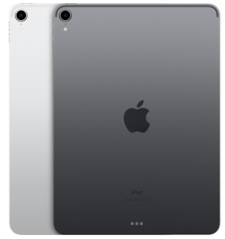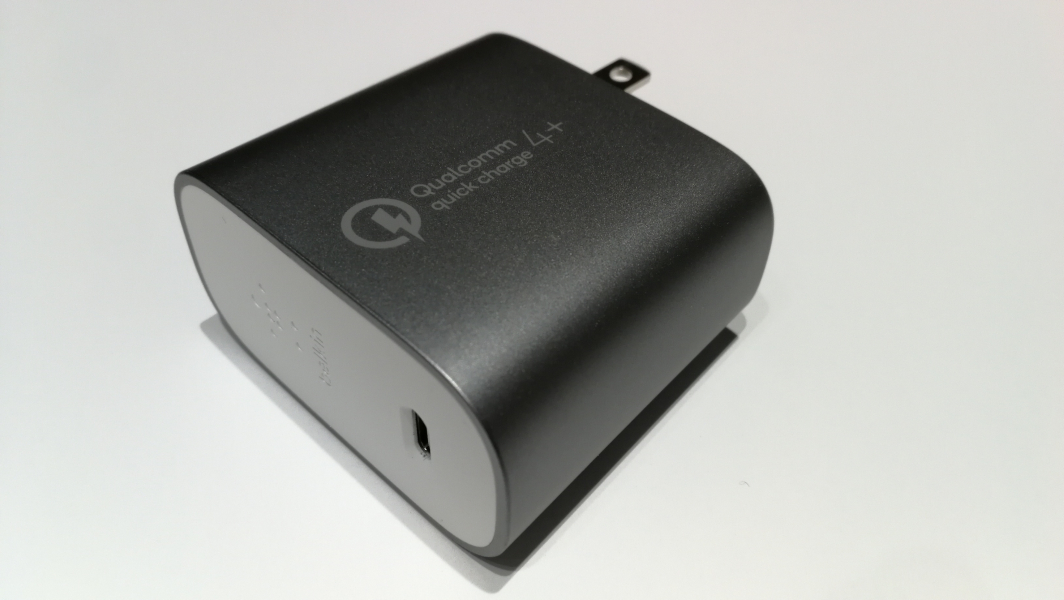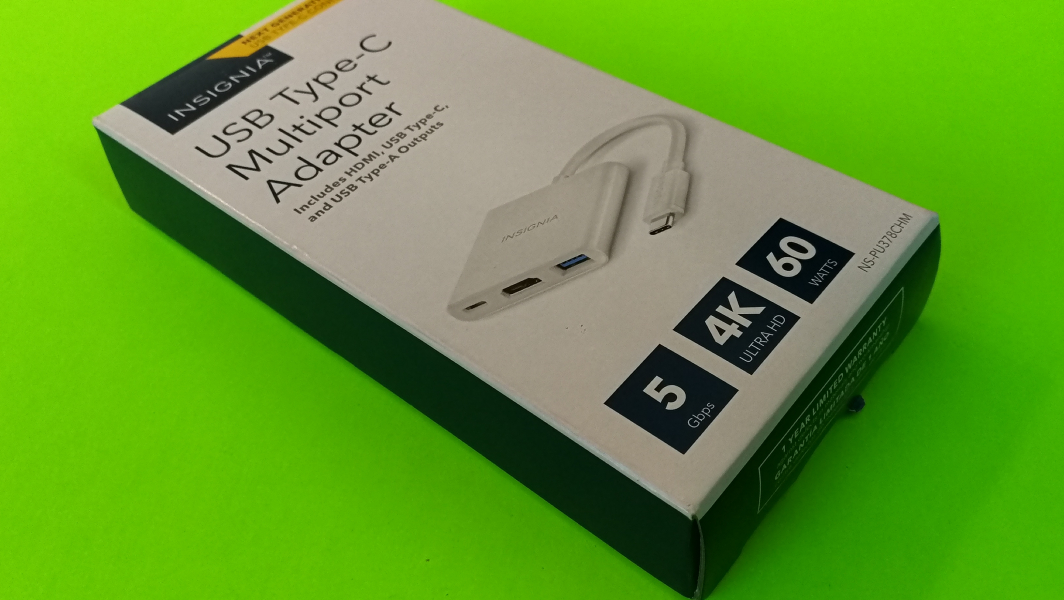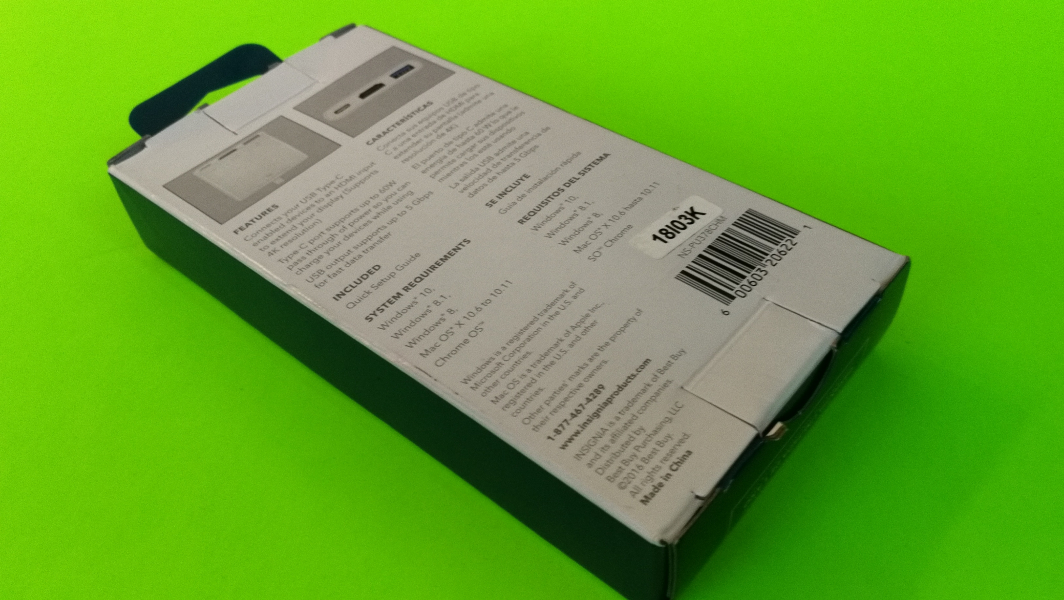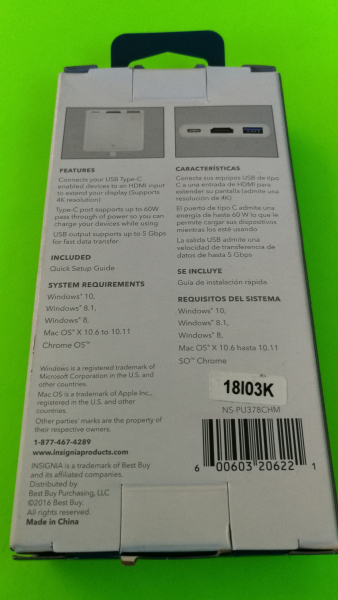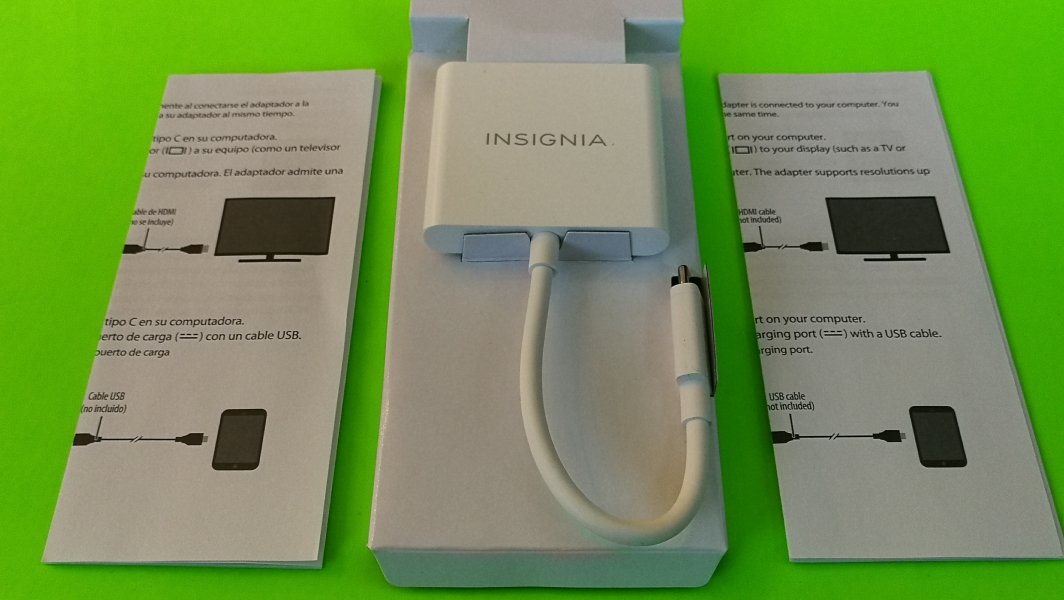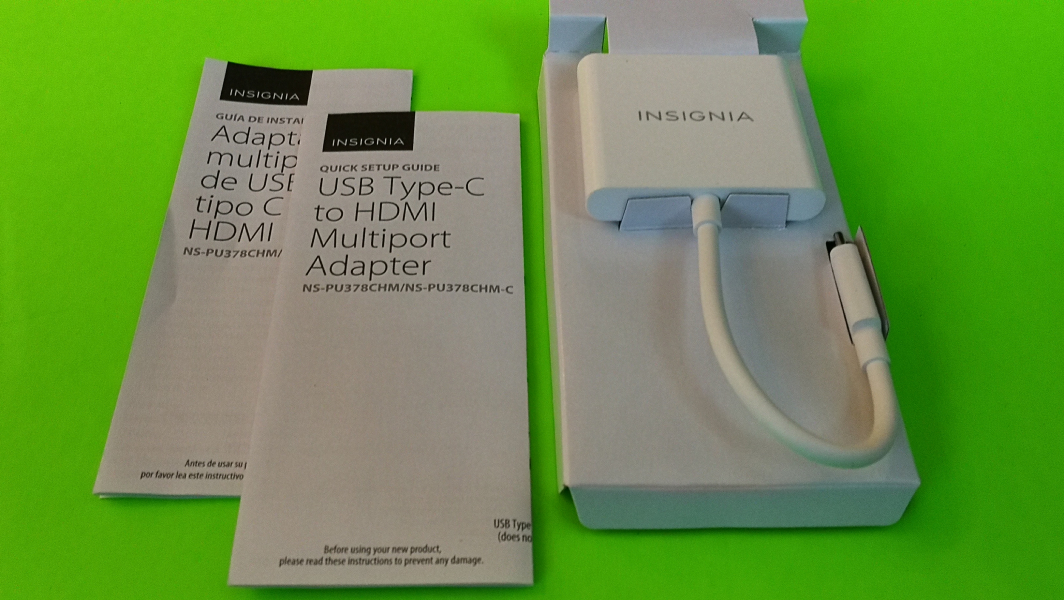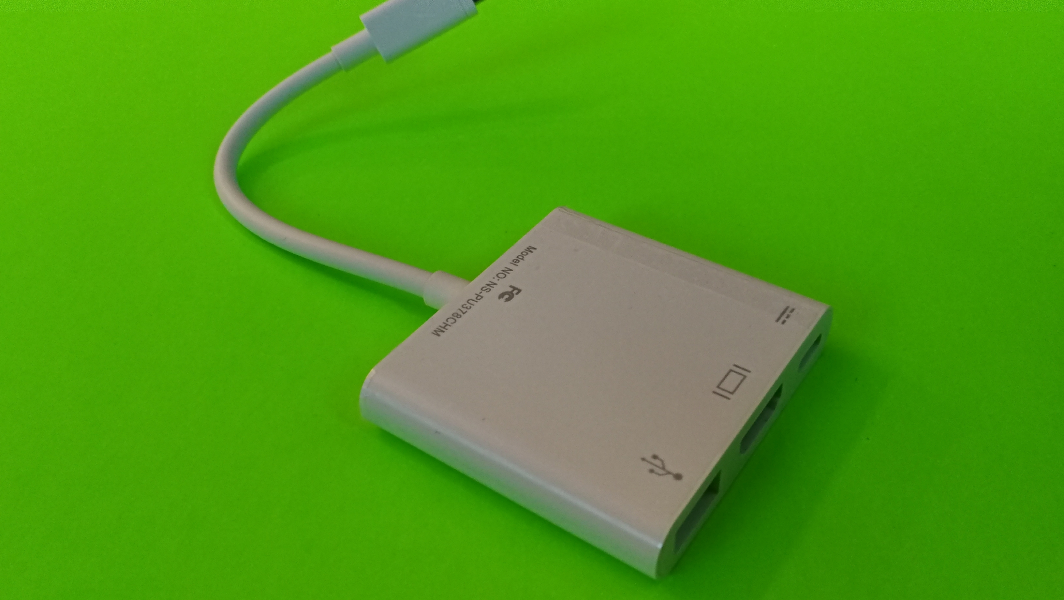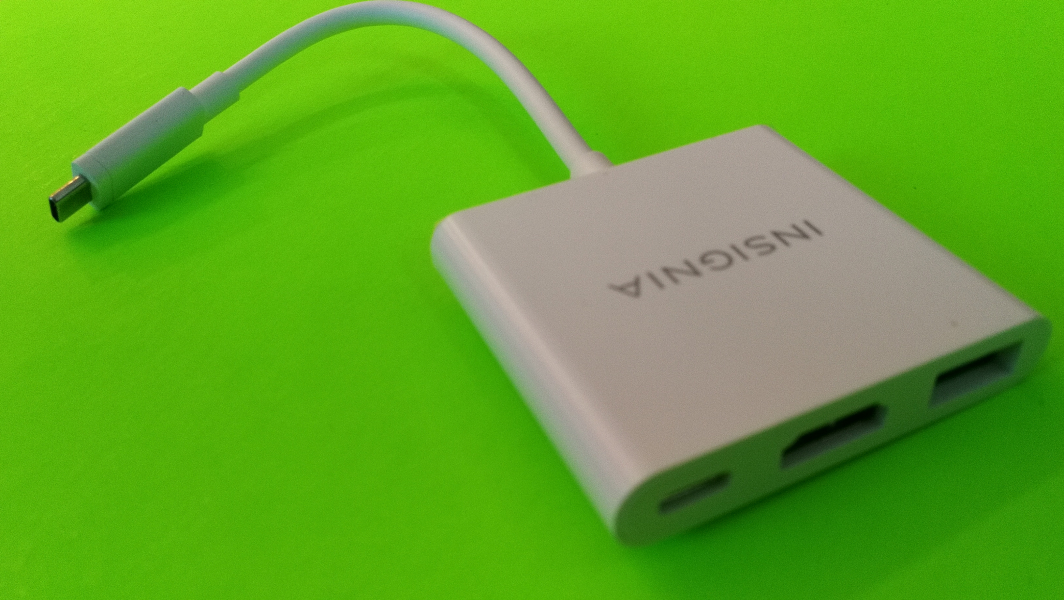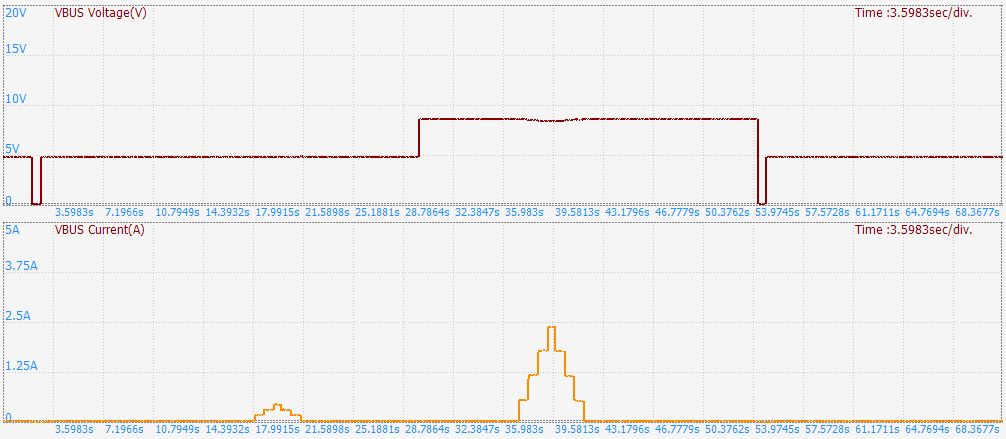For USB Type-C notebook PC's and tablets like Apple's MacBook Pro 2018 and 11-inch iPad Pro (2018) or the Google Pixelbook that have limited connectivity, the Insignia USB Type-C Multiport Adapter can be used to link up more devices to the computer. The Insignia USB Type-C Multiport Adapter enables charging, video output and data transfer when plugged in to most computers that support USB, DisplayPort Alternate Mode, and USB Power Delivery technologies over a single USB Type-C connector.
The Insignia USB Type-C Multiport Adapter connects to the computer using its tethered USB Type-C cable connector while supporting active USB Power Delivery 2.0 negotiation for rapid charging. The adapter supplies up to about 50W power level when connected to a external 60 watts based ac charger which we determined from our testing below. This leaves some power budget to support the other connectivity functions of the adapter which consist of one USB 3.1 Gen 1 (5 Gb/s) Type-A port, one HDMI 2.0 port and one 60W Type-C charging in port.
The Insignia USB Type-C Multiport Adapter allows 4K video when connected to a HDMI display through a DisplayPort Alternate Mode to HDMI conversion. The adapter can be connected to a external 60W USB Power Delivery ac charger through the USB Type-C downstream port for the adapter's own power supply which is also similar to the Anker Premium 7-in-1 USB-C Hub (see review here). There's also a USB Type-A port on the adapter for plugging in USB storage drives and peripherals.
We used the USB Power Test App from Granite River Labs with the Granite River Labs USB Power Delivery Compliance C2 Tester to generate the following test results for the Insignia USB Type-C Multiport Adapter.
The USB Power Test App can be used to determine the pass through power for each separate Type-C output and input ports of the Insignia adapter. For every PDO advertised into the adapter, the USB Power Test App increases the load gradually for each port to detect any power loss through the voltage and current that were passed through at their corresponding load limits. We can observe that the adapter limits the power thus connecting a Apple 87W charger to the adapter would be the same as connecting a 60W charger to the Apple MacBook Pro 2018 but with additional penalty since the adapter is using up to 10W of power itself which causes the Mac to only get 50W of power. Note that with this adapter, the MacBook Pro 2018 won't turn on quickly when in dead battery mode. You would need to plug in the Apple 87W charger in order to turn on the Mac quickly.
USB Type-C Input Port
USB Type-C Output Port
The USB Power Test App reports out the voltage, current and load limits for all the PDO's advertised into the Insignia adapter for each port.
| Port1 PDO | Port2 PDO | Port1 (V) | Port2 (V) | % | Port1 (A) | Port2 (A) | % |
|---|---|---|---|---|---|---|---|
| PDO#1 Fixed: 5V 3A | PDO#1 Fixed: 5V .5A | 5.1 | 5.02 | 98.5% | 0.53 | 0.44 | 83.3% |
| PDO#2 Fixed: 9V 3A | PDO#2 Fixed: 9V 2.44A | 9.03 | 8.81 | 97.5% | 2.47 | 2.4 | 97.1% |
| PDO#3 Fixed: 12V 3A | PDO#3 Fixed: 12V 2.58A | 12.05 | 11.8 | 97.9% | 2.62 | 2.55 | 97.4% |
| PDO#4 Fixed: 15V 3A | PDO#4 Fixed: 15V 2.67A | 15.03 | 14.78 | 98.4% | 2.71 | 2.64 | 97.4% |
| PDO#5 Fixed: 20V 3A | PDO#5 Fixed: 20V 2.75A | 5.04 | 5.04 | 99.8% | 0.09 | 0.01 | 14.5% |
| PDO#6 Fixed: 20V 5A | PDO#6 Fixed: 20V 2.75A | 5.04 | 5.06 | 100.2% | 0.08 | 0.02 | 26% |
We also used the USB Power Delivery Compliance C2 Tester from Granite River Labs to generate the following USB Power Delivery compliance test results for the tethered port of the Insignia USB Type-C Multiport Adapter as consumer. The Insignia adapter was connected directly to the computer without plugging in any ac power to the adapter. This causes the adapter's tethered port to act as a PD consumer and uses 10W for own power consumption.
USB Power Delivery Compliance on Insignia's Tethered Port (Consumer)
Parameter
|
GetCapabilities
|
|---|---|
PD_POWER_AS_SINK
|
10000
|
NUM_SNK_PDOS
|
1
|
Supply Type #1
|
Fixed
|
Voltage #1
|
0x64(5V)
|
OP Current #1
|
0xC8(2A)
|
PD Communication Engine Compliance Result Summary
Sl No
|
Test ID
|
Test Name
|
Test Result
|
|---|---|---|---|
1
|
TDA.2.1.1.1
|
TDA.2.1.1.1 BMC PHY TX EYE
|
PASS
|
2
|
TDA.2.1.1.2
|
TDA.2.1.1.2 BMC PHY TX BIT
|
PASS
|
3
|
TDA.2.1.2.2
|
TDA.2.1.2.2 BMC PHY RX INT REJ
|
PASS
|
4
|
TDA.2.1.2.1
|
TDA.2.1.2.1 BMC PHY RX BUSIDL
|
PASS
|
5
|
TDA.2.1.3.1
|
TDA.2.1.3.1 BMC PHY TERM
|
PASS
|
7
|
TDA.2.2.1
|
TDA.2.2.1 BMC PROT SEQ GETCAPS
|
PASS
|
13
|
TDA.2.2.10
|
TDA.2.2.10 BMC PROT IGN PPS
|
PASS
|
14
|
TDA.2.3.3.1
|
TDA.2.3.3.1 POW SNK TRANS C CP
|
PASS
|
The USB Power Delivery Compliance C2 Tester from Granite River Labs also produced the following USB Power Delivery compliance test results for the tethered port of the Insignia USB Type-C Multiport Adapter as provider (with a compliant ac power adapter connected to the adapter while the adapter was connected directly to the computer). This causes the adapter's tethered port to act as a PD provider and supports up to 22 watts (12 volts @ 1.83 amps) for charging out when connected to the Belkin 27W QC4+ Power Adapter which supports USB Power Delivery 3.0 based PPS (Programmable Power Supply) and Augmented PDO's using Qualcomm Quick Charge 4+ technology. Note compliance failures were observed.
USB Power Delivery Compliance on Insignia's Tethered Port (Provider)
Parameter
|
GetCapabilities
|
|---|---|
PD_POWER_AS_SOURCE
|
22000
|
NUM_SRC_PDOS
|
5
|
Supply Type #1
|
Fixed
|
Peak Current #1
|
0x0(A)
|
Voltage #1
|
0x64(5V)
|
Max Current #1
|
0x32(.5A)
|
Supply Type #2
|
Fixed
|
Peak Current #2
|
0x0(A)
|
Voltage #2
|
0xB4(9V)
|
Max Current #2
|
0xF4(2.44A)
|
Supply Type #3
|
Fixed
|
Peak Current #3
|
0x0(A)
|
Voltage #3
|
0xF0(12V)
|
Max Current #3
|
0xB7(1.83A)
|
Supply Type #4
|
Augmented_PDO
|
Min Voltage #4
|
0x21(3.3V)
|
Max Voltage #4
|
0x3(.3V)
|
Supply Type #5
|
Augmented_PDO
|
Min Voltage #5
|
0x21(3.3V)
|
Max Voltage #5
|
0x6(.6V)
|
PD Communication Engine Compliance Result Summary
Sl No
|
Test ID
|
Test Name
|
Test Result
|
|---|---|---|---|
1
|
TDA.2.1.1.1
|
TDA.2.1.1.1 BMC PHY TX EYE
|
PASS
|
2
|
TDA.2.1.1.2
|
TDA.2.1.1.2 BMC PHY TX BIT
|
PASS
|
3
|
TDA.2.1.2.2
|
TDA.2.1.2.2 BMC PHY RX INT REJ
|
FAIL
|
4
|
TDA.2.1.2.1
|
TDA.2.1.2.1 BMC PHY RX BUSIDL
|
PASS
|
5
|
TDA.2.1.3.1
|
TDA.2.1.3.1 BMC PHY TERM
|
PASS
|
7
|
TDA.2.2.1
|
TDA.2.2.1 BMC PROT SEQ GETCAPS
|
FAIL
|
11
|
TDA.2.2.7
|
TDA.2.2.7 BMC PROT BIST NOT 5V SRC
|
FAIL
|
13
|
TDA.2.2.9
|
TDA.2.2.9 BMC PROT GSC REC
|
PASS
|
14
|
TDA.2.3.1.1
|
TDA.2.3.1.1 POW SRC LOAD P PC
|
PASS
|
15
|
TDA.2.3.2.1
|
TDA.2.3.2.1 POW SRC TRANS P PC
|
PASS
|
The following test results show USB Power Delivery compliance for the ac power port of the Insignia USB Type-C Multiport Adapter as consumer which was also generated using the USB Power Delivery Compliance C2 Tester from Granite River Labs. The Insignia adapter was connected directly to the computer while the adapter was plugged in to a compliant ac power adapter where the adapter's ac power port acts as a PD consumer. We can also see that the adapter supports 10 watts (5 volts @ 2 amps) for charging in.
USB Power Delivery Compliance on Insignia's AC Power Port (Consumer)
Parameter
|
GetCapabilities
|
|---|---|
PD_POWER_AS_SINK
|
10000
|
NUM_SNK_PDOS
|
1
|
Supply Type #1
|
Fixed
|
Voltage #1
|
0x64(5V)
|
OP Current #1
|
0xC8(2A)
|
PD Communication Engine Compliance Result Summary
Sl No
|
Test ID
|
Test Name
|
Test Result
|
|---|---|---|---|
1
|
TDA.2.1.1.1
|
TDA.2.1.1.1 BMC PHY TX EYE
|
PASS
|
2
|
TDA.2.1.1.2
|
TDA.2.1.1.2 BMC PHY TX BIT
|
PASS
|
3
|
TDA.2.1.2.2
|
TDA.2.1.2.2 BMC PHY RX INT REJ
|
PASS
|
4
|
TDA.2.1.2.1
|
TDA.2.1.2.1 BMC PHY RX BUSIDL
|
PASS
|
5
|
TDA.2.1.3.1
|
TDA.2.1.3.1 BMC PHY TERM
|
PASS
|
7
|
TDA.2.2.1
|
TDA.2.2.1 BMC PROT SEQ GETCAPS
|
PASS
|
13
|
TDA.2.2.10
|
TDA.2.2.10 BMC PROT IGN PPS
|
PASS
|
14
|
TDA.2.3.3.1
|
TDA.2.3.3.1 POW SNK TRANS C CP
|
PASS
|
We further used the GRL-USB-PD C2 Compliance Test Solution App to produce the load trace below which shows the Insignia adapter supporting different voltage and current levels for charging.
 GTrusted
GTrusted






